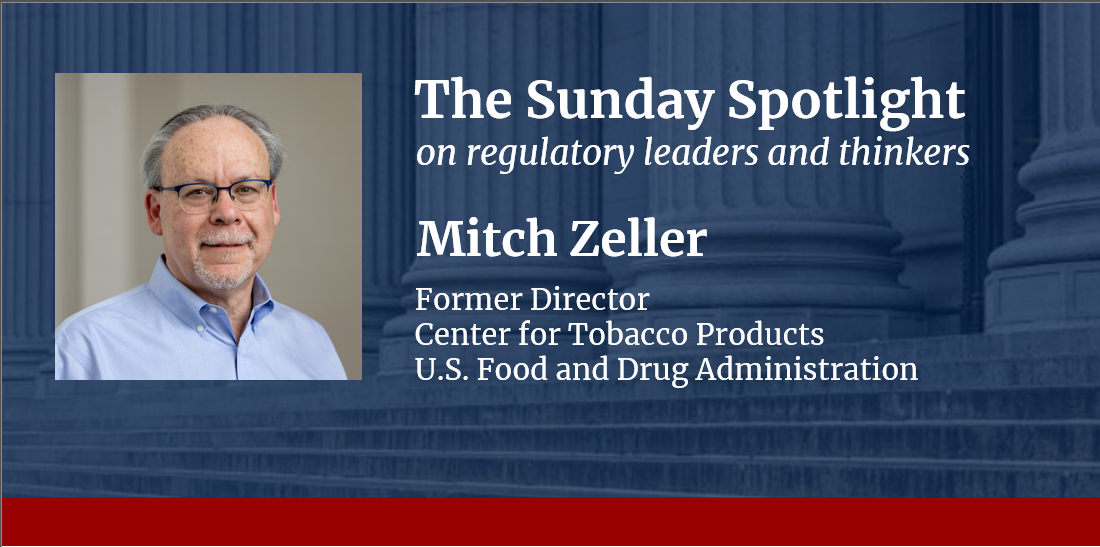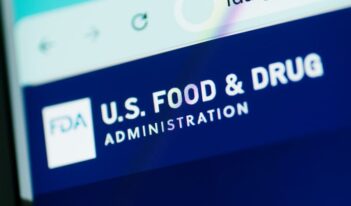
Mitch Zeller discusses the challenges of regulating to protect the public’s best interest.
In a conversation with The Regulatory Review, public health expert Mitch Zeller reflects on his tenure at the U.S. Food and Drug Administration (FDA) and shares how lessons from tobacco regulation can be applied to broader public health policymaking.
In 1994, FDA Commissioner David Kessler disrupted the status quo by launching an investigation into the practices of the tobacco industry and questioning the role of nicotine in tobacco products. Zeller joined Kessler in this effort and then was appointed to run FDA’s first Office of Tobacco Programs, embracing what he describes as a “once-in-a-lifetime” opportunity to help the agency claim the authority to regulate tobacco. Despite the U.S. Supreme Court’s eliminating “the entire FDA effort” in 2000, Zeller insists that the agency’s work in the 1990s was “absolutely worth it,” as it laid the foundation for FDA to “forever change the public’s understanding of the true nature of the cigarette industry.”
Congress later enacted legislation to give FDA jurisdiction over tobacco products. Still, Zeller notes, the agency has continued to confront challenges, especially in the absence of strong political leadership and an evolving marketplace for tobacco and nicotine products. Challenges such as these, Zeller explains, can make it more difficult for regulators to act in the public’s best interest. Although the path to regulatory success is riddled with uncertainty, Zeller leaves policymakers with this insight: “The more impactful a public health policy, the longer it is likely to take to see it go into effect. At some point, the time will be right.”
For over three decades, Zeller has worked to reduce tobacco-related harm through evidence-based regulation. Zeller launched his career in 1982 as a public interest attorney at the Center for Science in the Public Interest. After serving five years as counsel to the Human Resources and Intergovernmental Relations Subcommittee of the U.S. House of Representatives Government Operations Committee, he joined Kessler at FDA in 1993 and, a year later, helped support FDA’s investigation of the tobacco industry.
Zeller went on to serve as associate commissioner and director of FDA’s Office of Tobacco Programs. From 2013 to 2022, he led FDA’s Center for Tobacco Products, where he played an instrumental role in shaping the regulatory policies for tobacco and nicotine products. During his two stints at FDA, Zeller represented FDA at hearings before the U.S. Congress and represented the United States as a delegate to the World Health Organization’s working group for the Framework Convention on Tobacco Control. Zeller currently advises the start-up pharmaceutical company Qnovia, which is developing an inhalable smoking cessation product.
The Regulatory Review is pleased to share the following interview with Mitch Zeller.
The Regulatory Review: Looking back at your tenure leading FDA’s Center for Tobacco Products, what do you see as the most significant successes in regulating tobacco?
Zeller: I became the Center’s director in 2013 when it was still in the early stages of its development. There was no blueprint anywhere about how to build a center at FDA to regulate tobacco products. So, one accomplishment I am proudest of is simply helping to stand up and run this brand-new Center. We were 426 employees when I began and were 1,100 when I retired nine years later. Another accomplishment was protecting our employees from attempted political interference by the first Trump Administration.
More programmatically, completing what is known as the “Deeming Rule” in 2016 was significant as FDA finally got regulatory authority over previously unregulated products such as e-cigarettes. Another significant action was the release of a comprehensive plan in 2017 to regulate tobacco and nicotine. For the first time, FDA was on record as supporting a prohibition on menthol in cigarettes and mandating reductions in the nicotine content of cigarettes to minimally or non-addictive levels. We accomplished that, ironically, during the first Trump Administration because of the courage and leadership of the commissioner at that time, Scott Gottlieb.
If I could add one more, it would be the second rulemaking on pictorial health warnings on cigarette packs and ads. The first rulemaking was overturned by the courts. The constitutionality of our second rule was upheld by, of all federal courts, the U.S. Court of Appeals for the Fifth Circuit. More recently, the Supreme Court refused the industry cert petition on the constitutional issue. There is still a procedural issue to be litigated.
TRR: What was your role in FDA’s first push to seek regulatory control over tobacco in the 1990s?
Zeller: Former FDA Commissioner David Kessler recruited me from my role as counsel to an oversight committee in the U.S. House of Representatives to join FDA as a political appointee at the beginning of the Clinton Administration in 1993. At the time, he said the day would come when he would need my help to regulate tobacco. That day came about a year later when he asked me to work with him as FDA mounted an investigation of the role of nicotine in cigarettes and smokeless tobacco products. Kessler and I oversaw an investigation that took over two years and led to the assertion of jurisdiction over tobacco products in 1996. Kessler then named me the director of FDA’s first Office of Tobacco Programs, which I ran from 1997 until 2000 when the entire FDA effort was shut down by the U.S. Supreme Court in FDA v. Brown & Williamson Tobacco Corporation.
On a personal level, the opportunity that Kessler gave me was truly once-in-a-lifetime. From the beginning, I knew we were working on something that was historic. We did not know where it was going to take us or how it was going to end. I look back with great pride on what we did during my first stint at FDA in the 1990s.
TRR: FDA’s initial efforts to regulate tobacco culminated in the U.S. Supreme Court’s 2000 decision in Brown & Williamson. Was it worth it to try to push for FDA authority over tobacco in the 1990s only to have the Supreme Court reject that claimed authority?
Zeller: Our efforts in the 1990s were absolutely worth it. FDA helped forever change the public’s understanding of the true nature of the cigarette industry. For decades, the tobacco companies had insisted that nicotine was not addictive. Through our investigation and assertion of jurisdiction, we proved overwhelmingly that those companies knew that they were in the drug delivery business. The drug was nicotine. The delivery vehicle was the cigarette.
The Supreme Court never contested any of our findings. What the Court did do, however, was engage in a legal sleight of hand to avoid application of the now-defunct Chevron doctrine—under which courts deferred to reasonable agency interpretations of ambiguous statutes— which was still very much alive when Brown & Williamson was decided 25 years ago.
In Brown & Williamson, the Court conceded the validity of the Chevron doctrine but created a legally dubious escape clause for itself by contending that the doctrine somehow did not apply in extraordinary cases. The Court then went on to state that the FDA matter was “hardly an ordinary case” because the agency had asserted jurisdiction over “an industry constituting a significant portion of the American economy.” Remarkably, the Court then said that Chevron should not apply to tobacco products because “owing to its unique place in American history and society, tobacco has its own unique political history.”
The fact that the Supreme Court had to go through these legal contortions to side with the cigarette industry showed how powerful a case FDA had made that there should be regulation of these harmful products. Nine years later, Congress enacted legislation to put FDA back in the business of regulating tobacco products.
TRR: How has the evolution of tobacco and nicotine products—such as the rise of e-cigarettes and alternative nicotine delivery systems—challenged existing regulatory frameworks?
Zeller: The evolving marketplace for tobacco and nicotine products has been an extraordinary challenge for FDA. The regulatory framework is still intact. But the Center for Tobacco Products has had its budget capped, with no inflation adjustments, since 2019. The Center is completely funded by industry user fees. Not one dollar is collected from the e-cigarette industry even though much of the Center’s programmatic efforts are focused on that category. Congress must address the Center’s resource needs. The first Trump Administration agreed. Their final two budget submissions to Congress requested $100 million in new user fees and a mechanism to assess and collect fees from the e-cigarette industry.
TRR: What lessons from tobacco regulation can be applied to other areas of public health regulation, such as food safety, drug oversight, or environmental health?
Zeller: The greatest challenge I faced as the Center for Tabacco Product’s director from 2013 to 2022 was the difficulty of advancing impactful, game-changing policies. Why? Because the stakes are so high. In late 2012, I was recruited by the Obama Administration to return to federal service to run the Center. Promises were made to me, as part of my negotiations over whether I would return, that I would have the opportunity to advance two of the most impactful tobacco regulatory policies: prohibiting menthol in cigarettes and mandating a reduction in the nicotine content of cigarettes to minimally or non-addictive levels. Neither happened during the Obama Administration due to a lack of political will. Similarly, the Biden Administration lacked the political will to follow through with a menthol regulation.
So, the lesson to be learned is that political leadership must demonstrate political will when it comes to enacting far-reaching tobacco regulatory policies. The same can be said for other areas of science-based regulation, such as food safety and environmental health.
TRR: Are there any emerging public health threats that will require new regulatory approaches? If so, what are they?
Zeller: Right now, I think the greatest threat to public health is misinformation and disinformation. In a more enlightened administration, it would not be difficult to persuade regulators and other government officials that the top priority should be to overcome misinformation and disinformation on issues such as vaccines. That clearly will not be happening during the second Trump Administration.
If another pandemic arrives soon, as opposed to waiting another 100 years, we will need as nimble of a regulatory response as we saw during the COVID-19 outbreak in 2020.
TRR: What advice would you give to current and future regulators seeking to make an impact on public health policy?
Zeller: Have the courage of your convictions. And have patience.
I started working on FDA regulation of tobacco products in 1994. It did not become a fixture until legislation was enacted in 2009. I have been working to advance the evidence base and the policy case for nicotine reduction for almost 20 years. All we have to show for the effort is a proposed rule that is likely to be withdrawn in the second Trump Administration.
The more impactful a public health policy, the longer it is likely to take to see it go into effect.
At some point, the time will be right.



